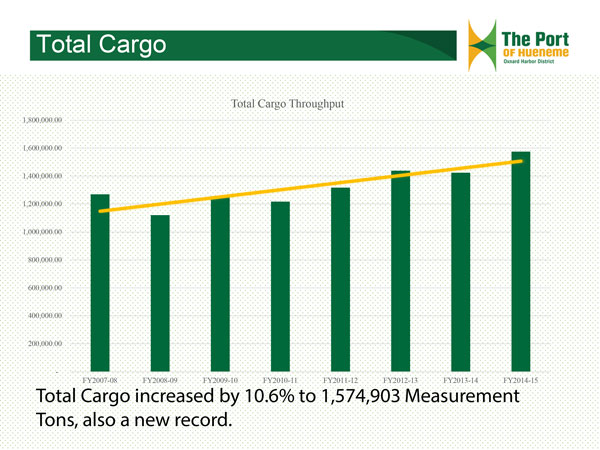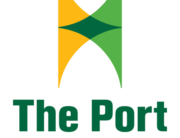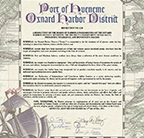#1 Trade Year in Port’s 78 year History
PORT OF HUENEME, CALIFORNIA – In a year that included coast wide congestion issues the Port of Hueneme is reporting its highest cargo year in its 78 year history. Overall auto traffic a niche for the Port increased by 10.6% to more than 321,000 autos. Total tonnage for FY 2014-2015 came in at a strong 1,574,903 metric tons representing a 9.5% increase from the Port’s all-time 2013 high. This represents a continuing path to economic growth keeping the Port at strong trade levels.
Referring to the healthy trade figures, Port Commission President Jess Herrera said, “The record cargo throughput in our port is not an accident but a reflection of the expertise that our facility brings to the maritime industry on every level. Making the most of our limited area, our dedicated staff, longshoremen and stevedores, continue to demonstrate our ability to make cargo move efficiently, safely, and in the most cost efficient manner possible. The Port of Hueneme has always been a port of opportunity, given the opportunity we provide results for our community and our customers.”
Strong freight activity growth was seen in the Port’s other niche markets of high and heavy cargos, fresh produce, fertilizer, and domestic commodities. Automobile imports which account for 60% of the Port’s business revenue boasted a robust 14.6% increase. A large percentage of the import increase was driven by foreign manufacturers redirecting autos intended for other markets to Hueneme and other Ports for temporary handling. Consistent with nationwide trends the strengthening US dollar has had an adverse impact on exports. Auto exports which reflect approximately 2% of Port revenue dropped by 26.6%.
BMW narrowly edged Hyundai/Kia in the import arena with a strong 14.4% growth. BMW’s overall processing volume through the Port of Hueneme’s Vehicle Distribution Center has increased over the same period last year and this trend is expected to continue for the remainder of this year.
Wallenius Wilhelmsen Logistics (WWL) is the leading shipper handling agricultural and heavy equipment cargo at the port, and provides shipping and technical processing for automobiles.
On the fruit side of the Port’s business portfolio banana imports remained strong at 655,643 metric tons. Total fresh fruits and vegetables (including bananas) handled by Port customers grew by a significant 5%. Other fresh fruit and vegetables (without bananas) increased by 34.1%. According to Del Monte’s Port manager Chuck Caulkins, “Del Monte Fresh Produce continues to perform strongly underscoring the importance of international trade for job creation and economic development both locally and across the state.” Adding to the fruit sector’s strong showing was citrus exports to Japan and Korea. 60% of the citrus was destined to Japan. The Port also grew fresh fruit sector numbers in grape exports to South America. Imported grapes and blueberries from Chile positively impacted overall numbers.
Other customers of the Port includes Yara North America Inc, who manages the liquid bulk fertilizer and Air1 Diesel Exhaust Fluid (DEF) through the Port and across North America. The Air1 Diesel Exhaust Fluid is a high purity solution of urea in water (32.5%), used to chemically reduce NOx emissions from trucks, buses and other units powered by diesel engines. Yara is the world’s largest producer and supplier of this product and the Port of Hueneme is a key supply point for the company’s western United States customer base. Overall numbers for Yara showed a 15% growth over last year.
Shallow draft cargo (fish, lube oil, and vessel fuel) grew by 4.2% for the year and the offshore domestic oil trade held steady. General Cargo (non-perishable and non-auto) was up by an explosive 54.3%,
Port Director Kristin Decas remarked on some of the core reasons for the Port’s steady growth, “This year’s cargo performance sets a new milestone for the Port. This achievement is driven by our customers and business development team. We’re committed to continuing our partnerships and strategic planning to maximize the social and economic benefit the Port brings to our community and industry sectors.”




